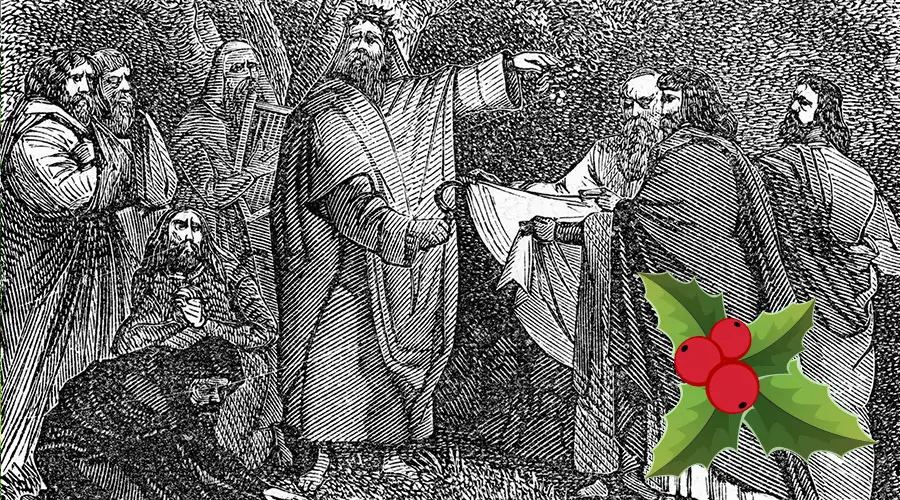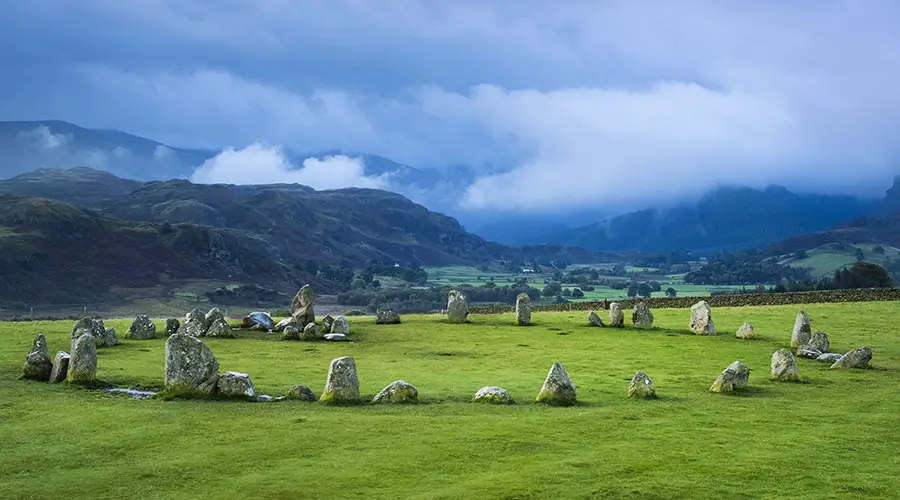
It is easy to see why the Druids inspire the imagination so much, with their white robes, practicing magic deep in the forests of Britain. At the center of their scientific and spiritual lives was the mistletoe plant. In this article we are going to answer the question: How did the druids use mistletoe?
The Druids were mystical priests who lived in Britain from around 200 B.C to 200 A.D. They possessed advanced knowledge of science and theology, which they only shared amongst their members. They placed great importance on nature, in particular the oak tree, and used the mistletoe which grow on the oak tree in their medicine and religious practices.
Druids and the Oak Tree
Some believe that the word Druid means “the men of the oak trees. The oaks are among the tallest and strongest trees of the forests of Europe, has the hardest and most compact wood, and can easily live over 700 years, reaching 10 stories in height. Like the Greeks before them, the Druids recognized the Oak as being sacred. The forest gods or tree deities of the Greeks were known as dryads. The word is also similar to the Gaelic word druidh, which means “wise man” or “sorcerer”. In Sanskrit the word dru means “timber”. The Druids would conduct their spiritual work deep in the groves of the oak trees of Britain. To them the oak tree was the symbol of the Supreme Deity, and it was from the oak tree that the druids would get their mistletoe.

The Ritual of Oak and Mistletoe
At certain carefully planned moments in the year, based on astrology, the Arch Druid would climb the oak trees and cut the mistletoe with a golden sickle. The mistletoe would be wrapped in white cloth for use later in their ceremonies, and great care was taken to ensure that it would never touch the ground. During the ceremony of cutting the mistletoe, the Druids would sacrifice two white bulls underneath the oak tree.
According to the Roman historian Pliny, the Druids considered anything that grew on the oak to have been sent from heaven, and that when mistletoe would grow on an oak tree it meant that god had selected that tree.
The Druids Used Mistletoe in Their Medicine
They also possessed knowledge of medicine, especially the use of herbs, but also were able to perform surgery to some extent. The Druids who practiced medicine would have their own garden of herbs for treating their patients. There are theories that the Druids even possessed magical healing abilities, which utilized magnetism, and made special magical brews with mistletoe that would operate on the astral plane to heal the sick. They believed that drinking the mistletoe would cure infertility and was an antidote to poisons. In the Druidic language the word for mistletoe translated to “all-healing”.

Interesting Facts About Mistletoe
- Mistletoe is actually poisonous to humans
- Injections of mistletoe are used to treat cancer
- There are over 1300 different kinds of mistletoe
- Currently there are 20 varieties of mistletoe which are considered endangered
- Mistletoe parasitizes a host, meaning it grows on other plants
- Today many believe that the act of kissing under the mistletoe will lead to marriage
- Mistletoe is a popular decoration for Christmas
The Druids Operated Like a Mystery School
Like their predecessors in ancient Egypt and Greece, the Druids operated as a mystery school, in that their knowledge was kept closely guarded, and only revealed to their members after being initiated into their order. Once initiated, members would be taught the Druidic Mysteries, which was not written but communicated orally. There are different theories on the origins of their knowledge, with some believing that it came from Phoenicians who had travelled to Britain in search of natural resources. The Druidic pantheon contains many Greek and Roman deities.
The Druids were held in such high regard by the people of Britain that they were consulted with for all important decisions, including warfare. The Druids wore white robes and had advanced knowledge of natural science, geography, theology, and astrology.

The Degrees of Druidism
The people who lived in Britain called their priests Gwydd. This evolved as they started having different levels of priests, so the higher level become known as Der-Wydd (Druid), while the secondary was O-Vydd (Ovate). Both classes of priests were known as Beird (Bards), which means teachers of wisdom. Eventually they had three classes: The Druids, the Ovates, and the Beirdd Braint, or privileged Bards.
The Ovate was an honorary degree and required no special preparation except for the possession of an exceptional character and potential. They wore green and were beginners in the study of the Druidic Mysteries, with limited access to knowledge. The young members of the Druids would be clean-shaven, while the older members wore long-grey beards. Many Gallic youth from continental Europe would go to Britain to attend the Druidic colleges, which offered a superior education. They would practice strict abstinence, and only be admitted after a long probationary period, and practiced strict secrecy.
The second degree were the Bard who wore blue. They were tasked with memorizing the extensive Druidic sacred poetry, which contains twenty thousand verses. They were often musicians who played the harp, and would tutor the Ovate.
The third degree were the Druids, who attended to the religious matters of the people. These were graduates of the Bards who had attained full initiation, and they would wear white, which symbolized the sun. Within the Druids There were six degrees of Druids, who all wore white robes but were distinguished by the color of their sash.
The Druids usually did not marry, and upon retiring would live very simple lives, sometimes as recluses in caves or little shacks in the forest, where they would pray and meditate.
The Arch-Druid of the Druids
At the top was the Arch-Druid, who was the highest-ranking member of the organization. There is debate around wither this position was hereditary and passed down from father to son, or was voted upon by the Druids. The Arch-Druid would wear a special breastplate called the iodhan moran, which according to legend would strangle anyone who made an untrue statement while wearing it. It was adorned with rich solar symbolism, suggesting that the Arch-Druid was the rising sun personified. He would also wear a special buckle on his belt which had a large white stone, and was said to give him the ability to summon the power of the gods. The stone was specially cut to concentrate the sun’s rays. The Arch-Druids unique attire also included a crescent-shaped sceptre. There were usually two Arch-Druids in Britain, one on the Isle of Anglesea, and the other on the Isle of Man.
The Philosophy of the Druids
According to the Druidic system of philosophy, there are three worlds which the soul can travel between. One of the three is the world above us, a place of happiness. Below us is another world of misery and sorrow, and the third world is the world in which we live. In our present world good and evil are balanced so that we may choose between the two. Our soul transmigrates to the upper or lower worlds depending on the choices we make in the present world.
The philosophy of the Druids was two-fold. They practiced a moral code, or sense of ethics, which was taught to all people. Everyone was taught that the soul is eternal and that reincarnation is real, and that there is a purgatory hell where the soul would be purged of its sins before moving on to salvation. They believed that some people would need to reincarnate to earth many times to learn how to transcend evil. The deeper more esoteric aspect of their knowledge was only shared amongst the initiated priests. Before these secrets were shared a member’s moral character would be thoroughly tested, and they would be required to take a vow of secrecy.
The Initiation Ceremonies of the Druids
Upon initiation, which would only occur on the two solstices and two equinoxes of the year, a new member would be taught the Druidic secrets in secret meetings in dense groves of oak trees or caves deep in the forest, where they would maintain fires. The new initiates would learn about the creation of the universe, laws of nature, occult medicine, astronomy and astrology, as well as magic and sorcery. The Druids recognized three kinds of knowledge: the nature, the cause, and the influence of each thing. They rejected darkness, falsehood, and death, and honored light, life, and truth.
To the Druids the new moon and full moon, as well as the sixth day of the moon, were sacred days, in which they would have special feasts. The druids would conduct ceremonies at midnight, which attendees would access via a glass boat. The boat represented the moon, floating upon the waters of eternity.
They also recognized nature spirits of the forest such as fairies and gnomes, and made offerings to these little creatures.
In one of their rites of passage, which few succeeded in passing, a candidate would be buried in a coffin, which symbolized the death of the Sun God. In another they would be sent out to sea in a small boat, and many hopefuls lost their lives undergoing this challenge. Upon successfully completing this degree of initiation, the Druid was considered reborn, and further knowledge was revealed to them.
Druids and the Romans
As Rome conquered Europe they came in contact with the Druids and considered them a threat because of their high level of education as well as the respect they commanded amongst other Celtic people. During the Gallic Wars of 58-51 B.C the Romans conquered the Gauls and introduced a ban on Druidism. Some of what is known about Druidism today comes from the account of Julius Caesar encountering the Druids, who described them in his writings, along with other Roman scholars. In 54 A.D Emperor Claudius banned the Druids from practicing their religion. In 60 A.D the Isle of Anglesey, and important location for the Druids, was invaded in an attempt to stamp out the existence of Druidism. Druidism then went in to hiding and was practiced in secret. You can read more about Julius Caesar’s impression of the Druids here.
Druids and Christianity
There are elements in the doctrine of the Druids that can be viewed as a sort of proto-Christianity. For example, they would celebrate December 25th, as the birth of the Sun god. Their doctrine included a Virgin Mother figure, and their Sun God was resurrected at the time that Christianity later made Easter. The symbol of the cross was important to them, which they would make out of the branches of the oak tree.
Druid Gods
The Druids were polytheistic, and many of the deities in their cosmology can be traced back to ancient Greece, possibly as a result of the Phoenicians sailing to Britain in search of tin. The gods of the Druids included Mercury, Apollo, Mars, and Jupiter, as well as many others. Deities would vary from region to region within Britain, and they had deities to represent love, agriculture, fertility, healing, and many other things.
Druids and Stonehenge
At times the Druids have been credited with building Stonehenge, but this is not actually true. Stonehenge, which is located in Southwest England, existed long before the Druids, dating back thousands of years. The Druids did however use the ancient site as a sacred place to conduct their rituals and ceremonies. If you would like to read more about ancient monuments, you can read my article about what may be hidden under the Sphinx in Egypt here.
Recommended Reading
If you’d like to continue researching the Druids as well as other mystical brotherhoods throughout history, you can see which books I recommend on the subject by clicking here.

